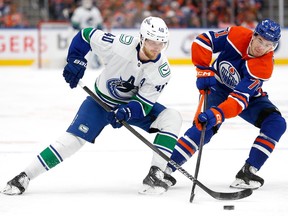There’s a reason why workers should know what each other is making: it takes bargaining power away from the owners.

Article content
There’s a story that upon his arrival in Detroit in 1968, Bobby Baun revealed to Gordie Howe that Mr. Hockey was wrong to think he was the best-paid player in the game.
Advertisement 2
Article content
For years, Red Wings general manager Jack Adams is said to have assured Howe that he was. Howe always took him at his word.
Then Baun told Howe how much he was making: nearly $20,000 more than the game’s greatest player.
That revelation drove Howe to march into the Wings’ offices and demand the raise everyone knew he was worth — but obviously years too late.
It’s impossible to imagine such a scenario today.
There’s a reason the NHL Players’ Association has long shared player salaries around its membership, they also post annual compensation totals for public view on their website: it’s in the interest of the players to know what everyone else is making.
There’s been plenty of chatter this week about how the NHL should build its own corporate version of CapFriendly, the nine-year-old salary cap tracking website that’s being bought by the Washington Capitals.
Article content
Advertisement 3
Article content
The salary cap is a fascination to players and fans alike. The NHL’s cap era has been going on for 19 years. How much a player makes matters more than ever.
And you can bet that fans aren’t the only ones who loved looking at CapFriendly.
Players and their agents were looking at it all the time, too.
“So simple and straightforward,” longtime player agent Michael Deutsch said Wednesday.
The top reason, obviously, was to see how much everyone is making.
Its open-source nature helped everyone understand where salaries were at — and then project where salaries would go next.
Agents and players also make use of the NHLPA’s members-only website, which has the most accurate information on contract structures — bonuses, no-trade clauses and the like — for players and agents to pass around.
Advertisement 4
Article content
What made CapFriendly different was it was a one-stop shop for information that went beyond just contract structures.
It also helped fans and players understand the machinations of long-term injured reserve, of how cap hits were factored for players who signed after the start of the season.
“The easiest way to see where teams spend their money and what guys are making. Even for rosters and injuries. Definitely more interesting to me now as an ex-player though. I’m always looking at it,” ex-Canuck Brandon Sutter said.
And he’s not alone. Plenty of players do, Sutter added.
Sutter’s interest goes all the way back to the days of CapGeek, CapFriendly’s predecessor, which was the first website to aggregate player contracts for the public to see all in one place. CapGeek was founded by Halifax journalist Matthew Wuest, who died of cancer in 2015.
Advertisement 5
Article content
Shortly after Wuest’s death, two men, Jamie Davis and Dominik Zrim, stepped into the breach. Initially they designed competing sites, but by 2016 they had joined forces under the CapFriendly banner and expanded their site to become indispensable for people inside hockey.
Zrim has worked for the Chicago Blackhawks and San Jose Sharks in the past, while CapFriendly itself had data sharing agreements with a number of NHL teams and websites. The Capitals buying up CapFriendly means those teams are back to square one. Many are understood to already have backup plans, but a number clearly were caught off guard by this week’s news.
That some teams were prepared for CapFriendly to be bought shouldn’t be a surprise. Unfortunately there are a lot of savvy teams out there, but there are still a handful that are poorly run and with little appreciation for how the world works, despite their wealthy owners.
Advertisement 6
Article content
Those teams may be flying blind for awhile, up against players who will still have plenty of data to work with, even if it’s not publicly available for the time being. CapFriendly is expected to go dark some time in July.
Labour unions are always going to be in favour of public salary disclosure. It gives employees clarity on what they’re worth.
And that kind of organizing drives owners crazy.
And that’s a big reason the NHL surely isn’t interested in creating their own version of a salary-cap tracker.
Sure, they’d also prefer it if fans just took everything said by ownership and the league at face value, that they didn’t cast a critical eye at what is being projected.
But that’s not reality.
People are always fascinated by the ins and outs of sport. Figuring out how rosters are assembled is innate to fandom.
Advertisement 7
Article content
In that regard, CapFriendly also let fans play GM, with a tool that allowed users to modify rosters as they pleased, estimating what teams could do to clear more cap space or figure out what could be done with the cap space as it existed.
There’s little doubt a new entrant will emerge, but don’t expect the league to lead the way: it’s just not in their interest.
Recommended from Editorial
Bookmark our website and support our journalism: Don’t miss the news you need to know — add VancouverSun.com and TheProvince.com to your bookmarks and sign up for our newsletters here.
You can also support our journalism by becoming a digital subscriber: For just $14 a month, you can get unlimited access to The Vancouver Sun, The Province, National Post and 13 other Canadian news sites. Support us by subscribing today: The Vancouver Sun | The Province.
Article content





